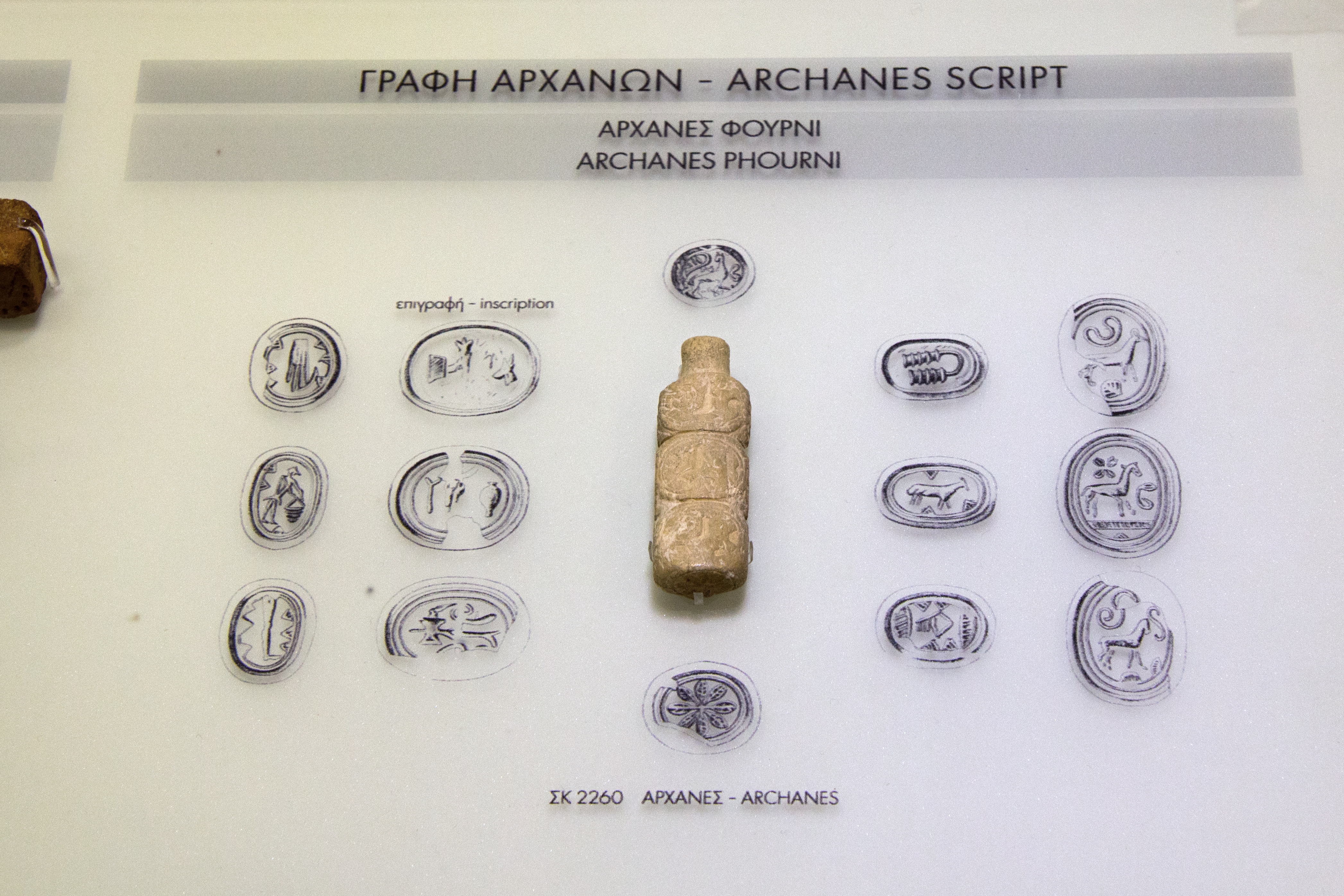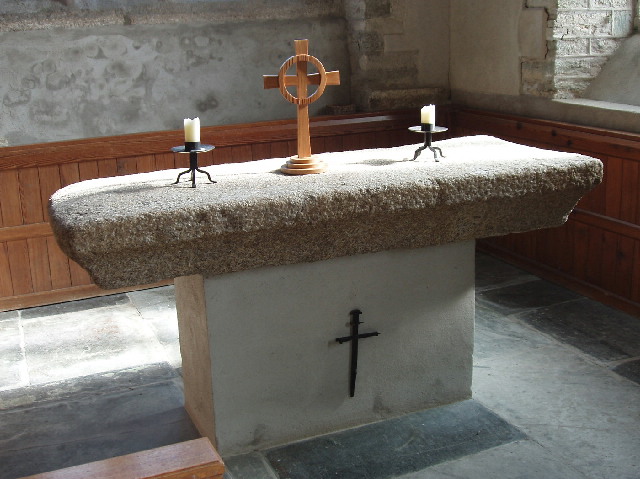|
Malia Altar Stone
The Malia altar stone is a stone slab bearing an inscription in Cretan hieroglyphs. It was found by a farmer near Malia, Crete. Chapouthier describes the find from an archeologist point of view. Olivier and Godard (1996) present several photographs of the Malia altar stone, which they list as item 328 in their inventory of Cretan hieroglyphs inscriptions. The stone has a cuplike cavity and is thought to be a Minoan altar stone. The side of the Malia altar stone contains an inscription with sixteen glyphs. The inscription is the only known instance of Cretan hieroglyphs on stone and is significant as one of the longest Cretan hieroglyphic inscriptions. Of the sixteen glyphs of the inscription, three occur twice each. Some of the glyphs show similarities with those of the Arkalochori Axe and the Phaistos Disc The Phaistos Disc (also spelled Phaistos Disk, Phaestos Disc) is a disk of fired clay from the Minoan palace of Phaistos on the island of Crete, possibly dating to the ... [...More Info...] [...Related Items...] OR: [Wikipedia] [Google] [Baidu] |
Cretan Hieroglyphs
Cretan hieroglyphs are a hieroglyphic writing system used in early Bronze Age Crete, during the Minoan era. They predate Linear A by about a century, but the two writing systems continued to be used in parallel for most of their history. , they are undeciphered. Corpus As of 1989, the corpus of Cretan hieroglyphic inscriptions included two parts: * Seals and sealings, 150 documents with 307 sign-groups, using 832 signs in all. * Other documents on clay, 120 documents with 274 sign-groups, using 723 signs. More documents, such as those from the Petras deposit, have been published since then. A four sided prism was found in 2011 at Vrysinas in western Crete. These inscriptions were mainly excavated at four locations: *"Quartier Mu" at Malia ( Middle Minoan II period = MM II) *Malia palace (MM III) *Knossos (MM II or III) *the Petras deposit (MM IIB), excavated starting in 1995 and published in 2010. The first corpus of signs was published by Evans in 1909. The current corpus ... [...More Info...] [...Related Items...] OR: [Wikipedia] [Google] [Baidu] |
Malia (city)
Malia or Mallia ( el, Μάλια) is a coastal town and a former municipality in the northeast corner of the Heraklion regional unit in Crete, Greece. Since the 2011 local government reforms it is part of the municipality of Hersonissos, of which it is a municipal unit. It lies east of Heraklion, the Cretan main city. The town (pop. 3,224 in 2011) was the seat of the municipality of Mália (pop. 5,433). The municipal unit also includes the villages of Mochos (Greek: Μοχός) (825), Krasi (Greek: Κράσι) (147), and Stalida (Greek: Σταλίδα) (1,237), and has a total land area of . The town is a tourist attraction, primarily for its significant archaeological site and nightlife. The Minoan town ruins lie three km east of the site and cover an area of approximately . The original name for the town is not known. History The palace of Malia, dating from the Middle Bronze Age, was destroyed by an earthquake during the Late Bronze Age; Knossos and other sites were also dest ... [...More Info...] [...Related Items...] OR: [Wikipedia] [Google] [Baidu] |
Crete
Crete ( el, Κρήτη, translit=, Modern: , Ancient: ) is the largest and most populous of the Greek islands, the 88th largest island in the world and the fifth largest island in the Mediterranean Sea, after Sicily, Sardinia, Cyprus, and Corsica. Crete rests about south of the Greek mainland, and about southwest of Anatolia. Crete has an area of and a coastline of 1,046 km (650 mi). It bounds the southern border of the Aegean Sea, with the Sea of Crete (or North Cretan Sea) to the north and the Libyan Sea (or South Cretan Sea) to the south. Crete and a number of islands and islets that surround it constitute the Region of Crete ( el, Περιφέρεια Κρήτης, links=no), which is the southernmost of the 13 top-level administrative units of Greece, and the fifth most populous of Greece's regions. Its capital and largest city is Heraklion, on the north shore of the island. , the region had a population of 636,504. The Dodecanese are located to the no ... [...More Info...] [...Related Items...] OR: [Wikipedia] [Google] [Baidu] |
Bulletin De Correspondance Hellénique
Bulletin or The Bulletin may refer to: Periodicals (newspapers, magazines, journals) * Bulletin (online newspaper), a Swedish online newspaper * ''The Bulletin'' (Australian periodical), an Australian magazine (1880–2008) ** Bulletin Debate, a famous dispute from 1892 to 1893 between Henry Lawson and Banjo Paterson * ''The Bulletin'' (alternative weekly), an alternative weekly published in Montgomery County, Texas, U.S. * ''The Bulletin'' (Bend), a daily newspaper in Bend, Oregon, U.S. * ''The Bulletin'' (Belgian magazine), a weekly English-language magazine published in Brussels, Belgium * ''The Bulletin'' (Philadelphia newspaper), a newspaper in Philadelphia, Pennsylvania, U.S. (2004–2009) * ''The Bulletin'' (Norwich) * ''The Bulletin'' (Pittsburgh), a monthly community newspaper in Pittsburgh, Pennsylvania, U.S. * ''London Bulletin'', surrealist monthly magazine (1938–1940) * ''The Morning Bulletin'', a daily newspaper published in Rockhampton, Queensland, Austral ... [...More Info...] [...Related Items...] OR: [Wikipedia] [Google] [Baidu] |
Minoan Civilization
The Minoan civilization was a Bronze Age Aegean civilization on the island of Crete and other Aegean Islands, whose earliest beginnings were from 3500BC, with the complex urban civilization beginning around 2000BC, and then declining from 1450BC until it ended around 1100BC, during the early Greek Dark Ages, part of a wider bronze age collapse around the Mediterranean. It represents the first advanced civilization in Europe, leaving behind a number of massive building complexes, Minoan art, sophisticated art, and writing systems. Its economy benefited from a network of trade around much of the Mediterranean. The civilization was rediscovered at the beginning of the 20th century through the work of British archaeologist Sir Arthur Evans. The name "Minoan" derives from the mythical Minos, King Minos and was coined by Evans, who identified the site at Knossos with the labyrinth of the Minotaur. The Minoan civilization has been described as the earliest of its kind in Europe, and his ... [...More Info...] [...Related Items...] OR: [Wikipedia] [Google] [Baidu] |
Altar Stone
An altar stone is a piece of natural stone containing relics in a cavity and intended to serve as the essential part of an altar for the celebration of Mass in the Catholic Church. Consecration by a bishop of the same rite was required. In the Byzantine Rite, the antimension, blessed and signed by the bishop, serves a similar function. History In contrast to the Jewish practice of building altars of several stones, the earliest Christian altars were of wood and shaped like ordinary house tables, a practice that continued until the Middle Ages. However, a preference for more durable materials led to church enactments in the West against wooden altars, but not in the East. The earliest stone altars were the tombs of martyrs, over which Mass was sometimes offered, either on a stone slab enclosing the tomb or on a structure placed above it. When the first custom-built Christian basilicas were built, the altar of the church was placed directly above the tomb of a martyr, as in the c ... [...More Info...] [...Related Items...] OR: [Wikipedia] [Google] [Baidu] |
Arkalochori Axe
The Arkalochori Axe is a 2nd millennium BC Minoan bronze votive double axe (''labrys'') excavated by Spyridon Marinatos in 1934 in the Arkalochori cave on Crete, which is believed to have been used for religious rituals. It is inscribed with fifteen symbols. It has been suggested that these symbols might be Linear A, although some scholars disagree. The labrys and the Phaistos Disc are conserved in the Heraklion Archaeological Museum. They share some symbols. Inscription Of the fifteen signs, two appear to be unique. The following suggestions for comparison with Linear A and Phaistos Disc glyphs A glyph () is any kind of purposeful mark. In typography, a glyph is "the specific shape, design, or representation of a character". It is a particular graphical representation, in a particular typeface, of an element of written language. A g ... are attributed to Torsten Timm (2004).PDF 0.5 Mb Reading top to bottom, right to left, the symbols are: Note that reading top to b ... [...More Info...] [...Related Items...] OR: [Wikipedia] [Google] [Baidu] |
Phaistos Disc
The Phaistos Disc (also spelled Phaistos Disk, Phaestos Disc) is a disk of fired clay from the Minoan palace of Phaistos on the island of Crete, possibly dating to the middle or late Minoan Bronze Age ( second millennium BC). The disk is about in diameter and covered on both sides with a spiral of stamped symbols. Its purpose and its original place of manufacture remain disputed. It is now on display at the archaeological museum of Heraklion. The disc was discovered in 1908 by the Italian archaeologist Luigi Pernier in the Minoan palace-site of Phaistos, and features 241 tokens, comprising 45 distinct signs, which were apparently made by pressing hieroglyphic "seals" into a disc of soft clay, in a clockwise sequence spiralling toward the center of the disk. The Phaistos Disc captured the imagination of amateur and professional archaeologists, and many attempts have been made to decipher the code behind the disc's signs. While it is not clear that it is a script, most attempted ... [...More Info...] [...Related Items...] OR: [Wikipedia] [Google] [Baidu] |
Stones
In geology, rock (or stone) is any naturally occurring solid mass or aggregate of minerals or mineraloid matter. It is categorized by the minerals included, its chemical composition, and the way in which it is formed. Rocks form the Earth's outer solid layer, the crust, and most of its interior, except for the liquid outer core and pockets of magma in the asthenosphere. The study of rocks involves multiple subdisciplines of geology, including petrology and mineralogy. It may be limited to rocks found on Earth, or it may include planetary geology that studies the rocks of other celestial objects. Rocks are usually grouped into three main groups: igneous rocks, sedimentary rocks and metamorphic rocks. Igneous rocks are formed when magma cools in the Earth's crust, or lava cools on the ground surface or the seabed. Sedimentary rocks are formed by diagenesis and lithification of sediments, which in turn are formed by the weathering, transport, and deposition of existing rocks. M ... [...More Info...] [...Related Items...] OR: [Wikipedia] [Google] [Baidu] |
Minoan Archaeological Artifacts
The Minoan civilization was a Bronze Age Aegean civilization on the island of Crete and other Aegean Islands, whose earliest beginnings were from 3500BC, with the complex urban civilization beginning around 2000BC, and then declining from 1450BC until it ended around 1100BC, during the early Greek Dark Ages, part of a wider bronze age collapse around the Mediterranean. It represents the first advanced civilization in Europe, leaving behind a number of massive building complexes, Minoan art, sophisticated art, and writing systems. Its economy benefited from a network of trade around much of the Mediterranean. The civilization was rediscovered at the beginning of the 20th century through the work of British archaeologist Sir Arthur Evans. The name "Minoan" derives from the mythical Minos, King Minos and was coined by Evans, who identified the site at Knossos with the labyrinth of the Minotaur. The Minoan civilization has been described as the earliest of its kind in Europe, and his ... [...More Info...] [...Related Items...] OR: [Wikipedia] [Google] [Baidu] |



.jpg)



